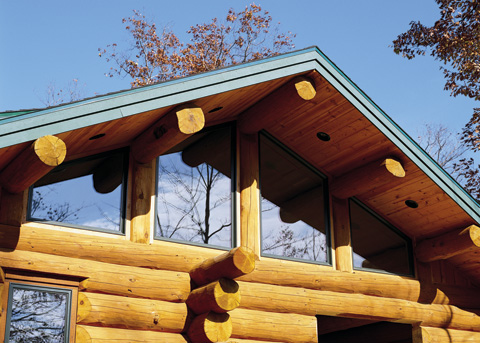Who hasn’t been drawn to the warmth of a sunny spot on a cold day, or cooled off in the shade during the dog days of summer? Passive solar design takes that natural comfort and incorporates it into the design of your house. Put simply, you can design your home to gather and make use of the sun’s light and warmth in the winter, while minimizing the warming effects of the sun in the summer. The result: a comfortable, bright, efficient home.
There are many factors to take into consideration when incorporating passive solar principles into your design, from the building site and how you orient your home on the lot to the materials and finishes you use. One of the most important things to keep in mind is your choice of windows and doors, as those are major sources of air and light infiltration.
First, think about where you place your windows. Naturally, you’ll want to make the most of your views, but keep in mind that direct sunlight can really heat up a house. With some guidance from your home designer or architect, you can plan to orient windows to reap the most passive solar benefits. East- and west-facing windows should be shaded by awnings or roof overhangs, or even by well-placed trees. In the colder regions of the country, it is ideal to have most of your windows facing within 30 degrees of due south to capture the sun’s warmth in the winter.
 Next, consider the types of windows and doors available. Most manufacturers offer window glass with special coatings to filter the sun’s rays. Low-emissivity or “Low-E” windows cost 10 to 15 percent more than standard windows, but are considerably more efficient. Low-E coatings can be applied to the outside of the window (to keep the sun’s heat out of the house) or on the inside (to trap heat and keep the house warm), depending on your climate. It is also possible to purchase Low-E films to apply yourself—an inexpensive way to save energy without having to replace your windows.
Next, consider the types of windows and doors available. Most manufacturers offer window glass with special coatings to filter the sun’s rays. Low-emissivity or “Low-E” windows cost 10 to 15 percent more than standard windows, but are considerably more efficient. Low-E coatings can be applied to the outside of the window (to keep the sun’s heat out of the house) or on the inside (to trap heat and keep the house warm), depending on your climate. It is also possible to purchase Low-E films to apply yourself—an inexpensive way to save energy without having to replace your windows.
Like many companies, Andersen Windows produces a number of glass options to allow customers to choose the energy efficient window that best suits their needs. “One option is PassiveSun™,” says Stacy Einck-Eckberg, brand public relations and social media manager for Andersen. “This glass option is ideal for northern climates where the application of passive solar design and construction is more common and solar heat gain is desired.”
Many manufacturers also make windows with a colorless gas (often argon or krypton) between the window panes. The gas is denser than air and acts as insulation, making the windows more energy efficient. Argon and krypton both occur naturally and are odorless and nontoxic.
When choosing exterior doors, look for the most energy-efficient doors you can find, with good energy performance ratings from ENERGY STAR. Steel or fiberglass doors with a foam insulation core are an efficient choice while glass doors—especially sliders—will lose heat throughout the winter. If you have your heart set on glass doors look for Low-E coatings, as you would for windows, and consider French doors instead of sliding doors.
No matter what type of windows and doors you select, it pays to have them professionally installed. Improperly installed or insufficiently sealed windows and doors can make it hard to keep your home at a comfortable temperature year-round, not to mention the big energy bills that you are likely to incur.

